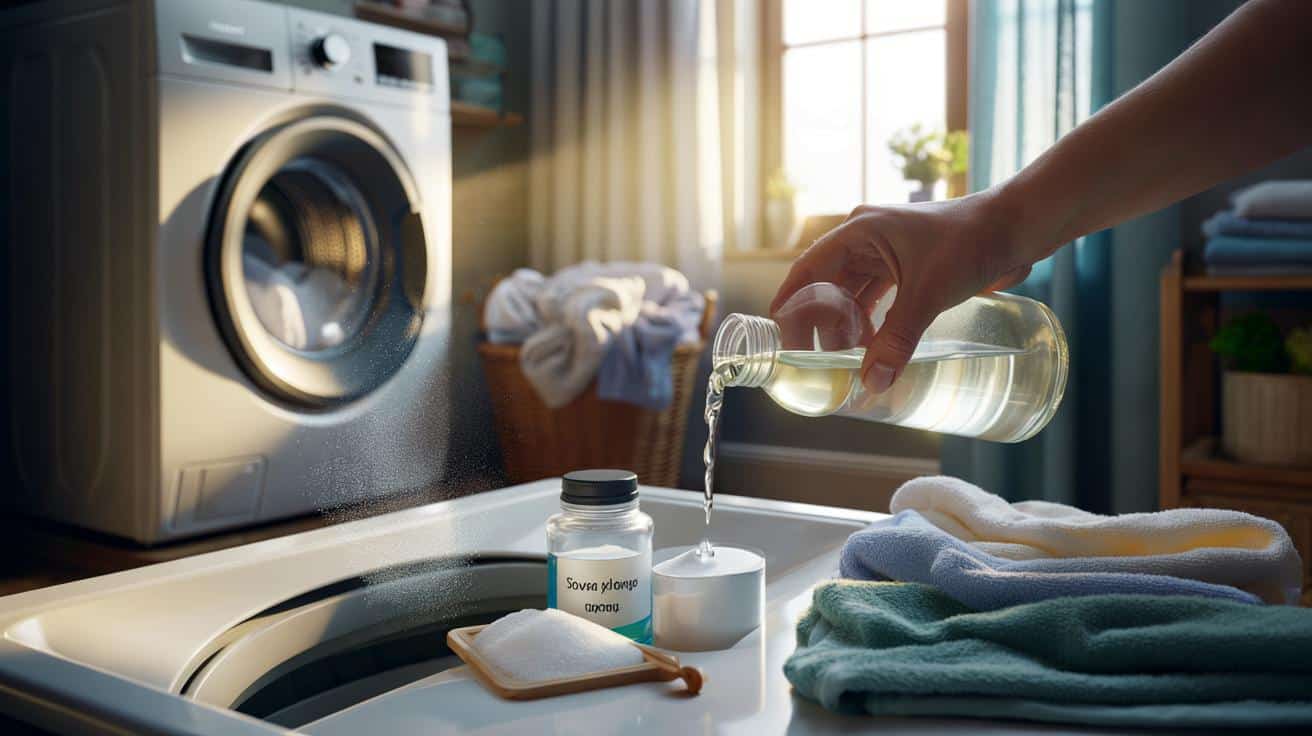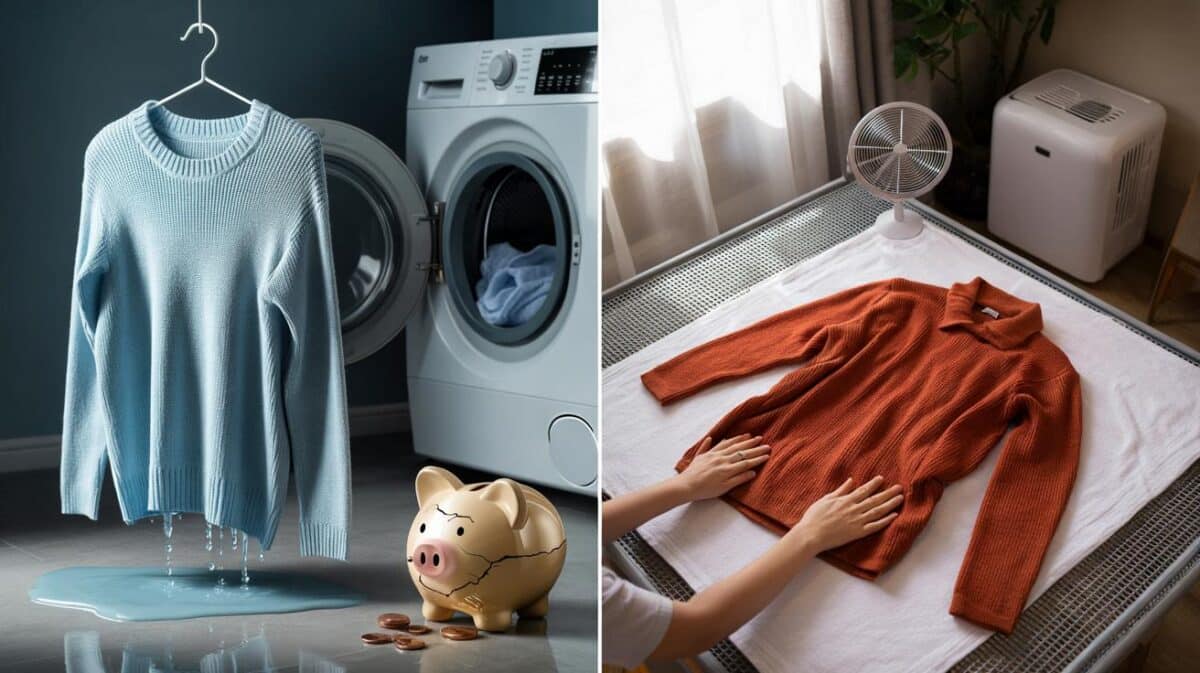Households are fixing it fast.
Across the country, people are pulling fresh towels from the machine only to catch a stale, musty note within hours. Low temperatures, heavy detergent doses and sluggish drying quietly set the stage for odour-causing bacteria. A low-cost reset—and a small change in routine—can turn that around without wrecking fabrics or budgets.
Why clean towels smell bad in the first place
Towels work hard. They absorb water, body oils and soap residue. When the fibres stay damp, bacteria settle in. A quick wash at 30–40°C shifts visible soil but often leaves the microbial party intact. Residual detergent coats loops, trapping moisture and feeding smells. Add slow drying in a closed bathroom, and the pong returns before the next shower.
Fabric softeners complicate things. They leave a silky film that flattens loops and reduces absorbency. Softer to touch, yes; but that film clings to odours and slows drying. The result feels plush yet smells tired.
Most towel odours start with trapped moisture and detergent build-up. Fix those, and freshness lasts.
The one reflex that changes everything
Set a monthly reset: wash towels at 60°C. This temperature disrupts biofilms and removes residues without roughing up decent cotton. You don’t need to do it every load. Once every three to four weeks is enough for most households.
Next, cut the detergent dose. Many people use 25–50% too much because more foam looks reassuring. In reality, excess detergent clings to fibres and resists rinsing. Use the lower end of the label’s guidance or reduce by a third if you have soft water. Towels come out cleaner and dry faster.
Add white vinegar to the rinse. 150–200 ml in the softener drawer neutralises odours, helps dissolve alkaline residue and brightens loops. The scent vanishes as the towel dries. It doesn’t replace detergent; it complements it. Avoid mixing vinegar with bleach or soda in the same stage, as they can cancel each other out or create fumes.
Monthly 60°C wash + lighter detergent dose + 150–200 ml white vinegar in the rinse = fresh, springy towels.
Step-by-step: a 10-minute reset that works
- Shake towels before loading to loosen fibres and improve water flow.
- Set 60°C, normal soil, high water level if available.
- Use 25–30% less detergent than you usually pour.
- Add 150–200 ml white vinegar to the softener drawer.
- Run an extra rinse if your machine allows it.
- Unload immediately and dry with space between towels.
Drying and storage make or break freshness
Speed matters more than scent. Move towels from drum to air within minutes of the cycle ending. Hang them with air gaps on a rotary line, a heated rail or a clothes horse under a window vent. In winter, crack a window or run an extractor to shift moist air. Don’t stack towels on a radiator; drape them so warm air circulates.
Never fold a towel that feels the slightest bit cool or clammy. Coolness signals residual moisture in the dense loops. Store only when fully dry, ideally warm to the touch. Rotate stacks so the same towels don’t sit compressed for weeks.
Dry within six hours of washing to stop odours from reforming inside the loops.
Common mistakes to avoid
- Leaving wet towels in the drum or laundry basket overnight.
- Using fabric softener on every load, which reduces absorbency.
- Overloading the machine so towels can’t agitate and rinse properly.
- Masking smells with heavy fragrance instead of fixing the cause.
- Drying in a closed, steamy bathroom with no airflow.
What settings really do: quick guide
| Setting or habit | What it changes | Likely outcome |
|---|---|---|
| 30–40°C quick wash | Removes light soil, leaves biofilm | Fresh at first, smells return fast |
| 60°C monthly cycle | Breaks down residues and bacteria | Longer-lasting freshness and bounce |
| Too much detergent | Residue traps moisture | Heavier towels, stubborn odours |
| White vinegar in rinse | Neutralises odours, softens water | Cleaner smell without perfume |
| Fast, ventilated drying | Removes moisture before bacteria multiply | Stable freshness between showers |
Keep the machine clean and the towels follow
Odours often start in the appliance. Wipe the door seal weekly. Rinse the detergent drawer. Run an empty 60–90°C maintenance cycle with 250 ml white vinegar every two months to flush residue. Clean the pump filter to improve drainage. Leave the door ajar so the drum dries between loads.
Cost, care and fabric safety
A 60°C cycle uses more energy than a 40°C one, but you only need it once a month for towels. That small bump in usage can save rewash costs and extend textile life because you won’t chase odours with repeated, ineffective cycles. Quality cotton towels are rated for 60°C; colours should stay solid if dyes are fixed. Test a corner the first time if you’re unsure.
Avoid chlorine bleach on cotton loops. It weakens fibres and makes towels shed. Oxygen-based whiteners can help with greying but use them sparingly and follow the label, especially on coloured towels. If your home has hard water, scale binds to fibres and holds smells. Vinegar in the rinse helps, as do soda crystals in the wash—just don’t add them at the same time as vinegar.
Hard water households: small tweaks that pay off
- Add 1–2 tablespoons of soda crystals with detergent to soften wash water.
- Use vinegar only in the rinse stage to avoid neutralising the soda.
- Run the monthly 60°C reset more often if towels feel stiff despite proper drying.
If towels already smell sour
Give them a deep reset. Wash once at 60°C with a reduced detergent dose and vinegar in the rinse. If the odour persists, run a second wash at 60°C using an oxygen-based laundry booster designed for colours or whites. Dry fully with generous airflow. If a towel still smells when dry, the fibres may be packed with residues from years of softener and heavy fragrance. A few successful resets usually restore them; if not, consider replacing low-quality towels that never quite dry out.
Extra pointers people ask about
How many uses between washes? Two to three uses per person is a practical rule if towels dry fully between showers. After gym sessions or illness, wash sooner. Can you tumble-dry? Yes, on medium heat; stop while towels feel slightly damp, then air-finish to reduce energy and keep loops springy. Prefer line drying when weather allows; sunlight helps with odour control.
What about microfibre or blended towels? Check the care label. Many microfibres prefer 40°C. If they smell, do a single 60°C cycle to reset, then return to 40°C with lighter detergent and fast drying. Keep softener away from microfibre entirely; it clogs performance fibres.
A small routine pays off. Set a monthly 60°C reset, lighten your detergent hand, add a measured splash of white vinegar, and dry with pace and airflow. The result feels luxurious on skin and stays fresh long after laundry day, even when winter damp sets in.








